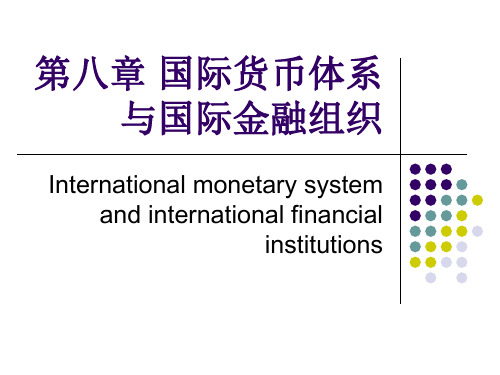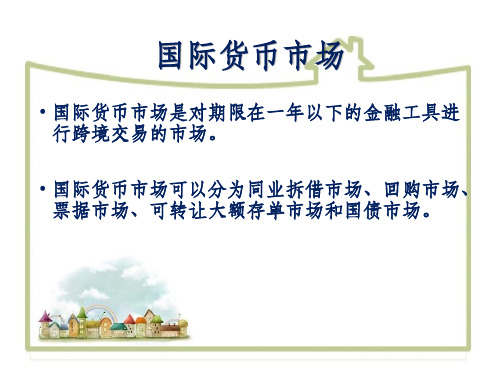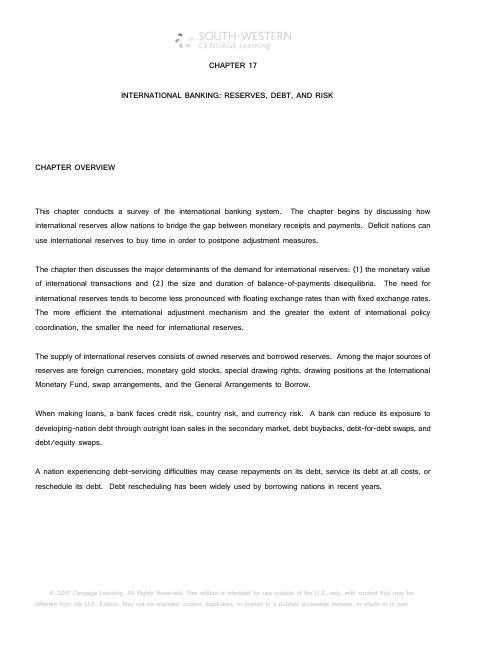International finance chapter 8 (国际金融英文版课件)
- 格式:ppt
- 大小:2.91 MB
- 文档页数:32






© 2011 Cengage Learning. All Rights Reserved. This edition is intended for use outside of the U.S. only, with content that may be different from the U.S. Edition. May not be scanned, copied, duplicated, or posted to a publicly accessible website, in whole or in partCHAPTER 17INTERNATIONAL BANKING: RESERVES, DEBT, AND RISKCHAPTER OVERVIEWThis chapter conducts a survey of the international banking system. The chapter begins by discussing how international reserves allow nations to bridge the gap between monetary receipts and payments. Deficit nations can use international reserves to buy time in order to postpone adjustment measures.The chapter then discusses the major determinants of the demand for international reserves: (1) the monetary value of international transactions and (2) the size and duration of balance-of-payments disequilibria. The need for international reserves tends to become less pronounced with floating exchange rates than with fixed exchange rates. The more efficient the international adjustment mechanism and the greater the extent of international policy coordination, the smaller the need for international reserves.The supply of international reserves consists of owned reserves and borrowed reserves. Among the major sources of reserves are foreign currencies, monetary gold stocks, special drawing rights, drawing positions at the International Monetary Fund, swap arrangements, and the General Arrangements to Borrow.When making loans, a bank faces credit risk, country risk, and currency risk. A bank can reduce its exposure to developing-nation debt through outright loan sales in the secondary market, debt buybacks, debt-for-debt swaps, and debt/equity swaps.A nation experiencing debt-servicing difficulties may cease repayments on its debt, service its debt at all costs, or reschedule its debt. Debt rescheduling has been widely used by borrowing nations in recent years.© 2011 Cengage Learning. All Rights Reserved. This edition is intended for use outside of the U.S. only, with content that may be different from the U.S. Edition. May not be scanned, copied, duplicated, or posted to a publicly accessible website, in whole or in partAfter completing the chapter, students should be able to:•Explain how international reserves allow nations to cope with balance-of-payments disequilibria. •Identify the determinants of the demand for international reserves. •Identify the major sources of international reserves. •Describe the risks that bankers face when making loans to international borrowers. •Discuss the options available to nations which experience debt-servicing difficulties. •Discuss the role of the International Monetary Fund in the world financial system.BRIEF ANSWERS TO STUDY QUESTIONS1. One drawback of a pure gold standard is that gold stocks might not grow as rapidly as international trade. Agold-exchange standard attempts to economize on gold as an international reserve by including key currencies (i.e., the U.S. dollar) as an international reserve.2.A reserve currency, such as the U.S. dollar or British pound, is a currency that trading nations are willing to hold along with other international reserve assets, such as gold.3.A country facing debt servicing problems has several options: (a) cease repayment on its debt, (b) service the debt at all cost, or (c) reschedule the debt.4. Debt equity swaps involve commercial banks selling their foreign loans to the foreign government for foreigncurrency which is then used to finance an equity investment in the foreign country. The equity investment is assumed to be a safer investment than the original loans made to the foreign borrower.5. Special drawing rights are unconditional rights to draw currencies of other countries. They were created bythe IMF to supplement the other forms of international reserve assets. The SDR's value is determined by the basket valuation technique.6. A country's debt-to-export ratio is the ratio of external debt to exports of goods and services. Changes in thisratio indicate whether a country's debt burden is rising or falling relative to its ability to pay. The debt service ratio refers to the scheduled interest and principal payments as a percent of export earnings.7. The international debt problem of the 1980s referred to the inability of some developing countries to pay backloans to Western commercial banks. The debt problem was intensified by factors including world recession, high interest rates, and the appreciation of the U.S. dollar.8. Foreign currencies constitute the most important component of the world's international reserves while specialdrawing rights constitute the least important component.9. A Eurocurrency is a deposit, denominated and payable in dollars and other foreign currencies, in banksoutside the United States. Dollar deposits located in banks outside the United States are known as Eurodollars.10. Owned reserves include monetary gold stocks, foreign currencies, and special drawing rights. Borrowedreserves include IMF drawings, swap arrangements, compensatory export financing, oil facility, and buffer stock facility.11. Since 1975 gold has been demonetized. Today, gold is considered a commodity by the InternationalMonetary Fund.12. Banks can reduce their exposure to developing country debt via several methods: (a) outright loan sales, (b)debt buybacks, (c) debt-for-debt swaps, or (d) debt/equity swaps.13. Similar to a householder's desire for cash balances, nations require international reserves to bridge the gapbetween monetary receipts and payments. Deficit nations require international reserves to finance their payments disequilibriums.14. When making international loans, bankers face the following risks: (a) credit risk, (b) country risk, and (c)currency risk.15. A country's demand for international reserves depends on the monetary value of international transactions aswell as the size and duration of payments disequilibriums.16. See Question 10.© 2011 Cengage Learning. All Rights Reserved. This edition is intended for use outside of the U.S. only, with content that may be different from the U.S. Edition. May not be scanned, copied, duplicated, or posted to a publicly accessible website, in whole or in part。